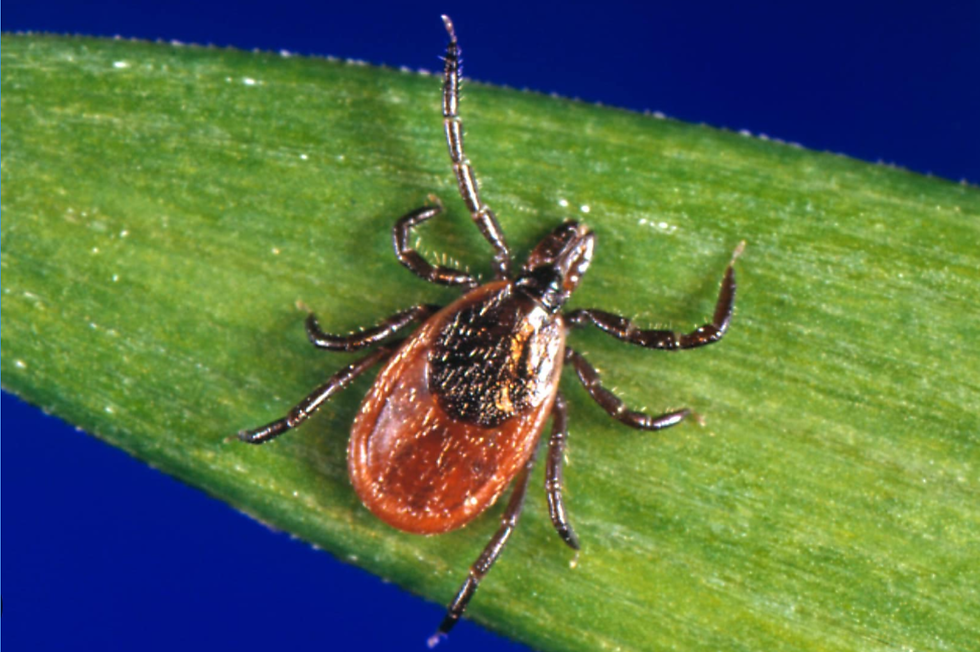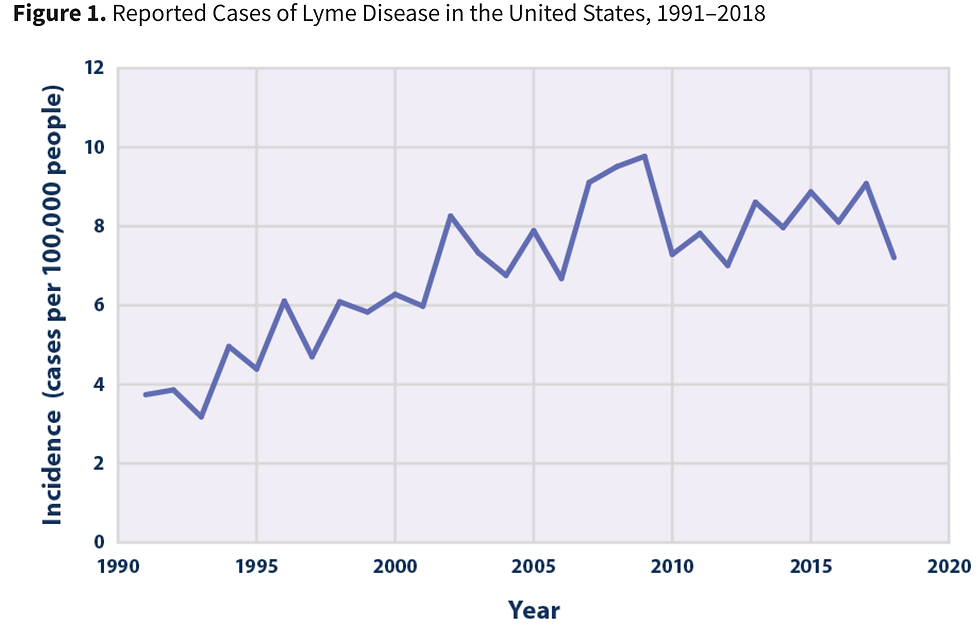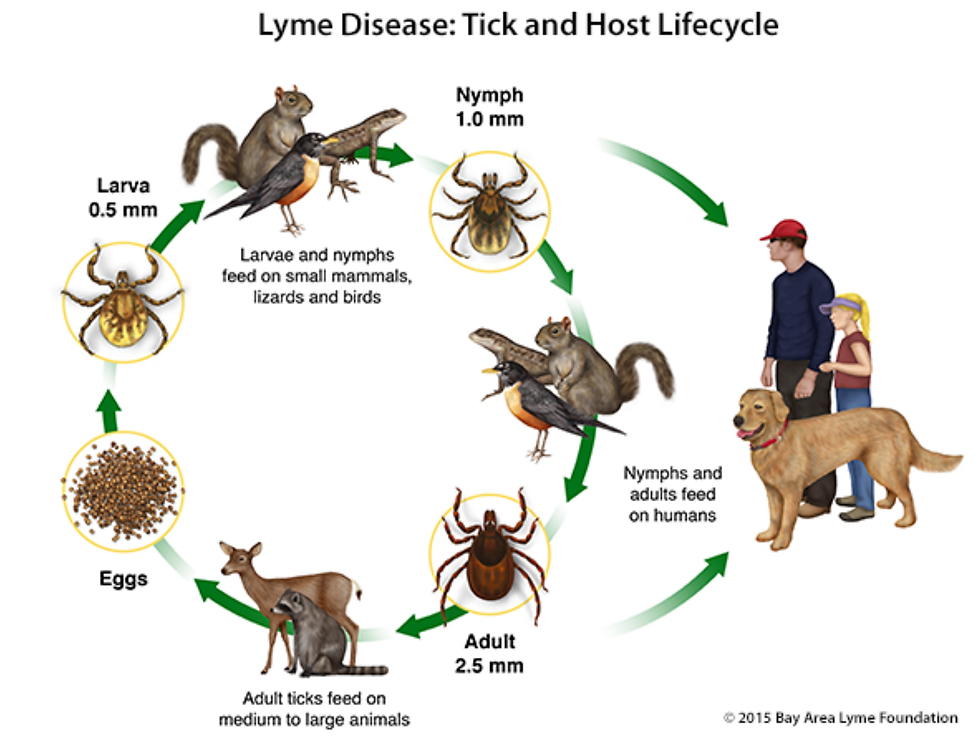Don't Get Ticked!
- sjpdragonlady
- Jul 15, 2024
- 10 min read
Updated: Aug 1, 2024

Center for Disease Control
Ticks: Volkert Volkersz
What is Lyme Disease?
Lyme Disease is a bacterial infection that causes rashes and joint pain, among other symptoms. The disease is spread to humans by bite of an infected blacklegged tick, also known as a deer tick. It is the most common tick-borne disease in the United States. The germ is a spiral-shaped bacteria called Borrelia burgdorferi. The infection is particularly common in the northeastern, mid-Atlantic, and north-central United States, although its range is spreading. It traditionally occurs in the fall, but there are now reports of Lyme Disease from May through December. Lyme Disease is generally easily treated with antibiotics, although some patients have been diagnosed with chronic Lyme Disease.
Borrelia burgdorferi
Science Source Prints
Why is Lyme Disease becoming a bigger problem?
Estimates from the Center for Disease Control suggest that as many as 476,000 people may be diagnosed and treated for Lyme disease in the United States each year. According to the Environmental Protection Agency, the incidence of Lyme Disease in the United States has nearly doubled in the past thirty years. It increased from 3.74 reported cases per 100,000 people in 1991 to 7.21 reported cases per 100,000 people in 2018. Elderly people are at particularly high risk, and the rates of Lyme Disease in individuals over the age of 65 years has approximately doubled. According to a 2022 study published in Emerging Infectious Diseases, the annual cost of Lyme disease in the United States is between $345–968 million. This estimate includes treatment costs and societal costs (such as missed work days). This enormous cost illustrates the importance of prevention and early diagnosis of this disease.

Environmental Protection Agency
Humans infections of Lyme Disease are spread primarily through the bite of infected deer ticks. The life cycle and prevalence of deer ticks are greatly influenced by temperature and humidity. Deer ticks are most active when temperatures are above 45˚F, and they thrive in areas with at least 85-percent humidity. According to the Environmental Protection Agency, warming temperatures associated with climate change are projected to increase the range of suitable tick habitat and are likely contributing to the observed spread of Lyme disease. With increasing temperatures, the risk of Lyme Disease has spread across the United States and into Canada, where ticks were previously unable to survive. Cold winters limit tick activity, and shorter winters may extend the period of tick activity and increase risk of Lyme Disease. Habitat disruption and loss of natural predators may bring tick-bearing animals such as deer and mice closer to homes, further increasing the exposure of humans to Lyme Disease. On the other hand, severe droughts and fires (worsening in the Southwest) may actually kill ticks, decreasing the risk of Lyme Disease in these areas.
WSILTV
How do people catch Lyme Disease?
for women First
The bacteria that cause Lyme disease in the United States, Borrelia burgdorferi and, rarely, B. mayonii, are spread to people through the bites of infected ticks. The blacklegged tick (or deer tick, lxodes scapularis) transmits Lyme Disease in the northeastern, mid-Atlantic, and north-central United States. The western blacklegged tick (lxodes pacificus) transmits infections in areas along the Pacific Coast. Blacklegged ticks found in most areas of the southeastern United States are rarely infected.The percentage of ticks that are infected ranges from 0-50%, depending on the area and life stage. Generally, a tick must be attached for at least 36–48 hours before it can transmit the bacteria that causes Lyme disease. Ticks that are found and removed more quickly usually don't have time to transmit Lyme Disease. Early symptoms of Lyme disease typically appear 3 to 30 days (average 7 days) after a bite from an infected tick.
People who spend time outdoors where the ticks live, such as grassy, brushy or wooded areas, are at high risk for Lyme Disease. Your pets can also bring ticks into the house and should be frequently checked for ticks, especially after walking or playing outdoors.
FREEP!K
People who work outdoors in regions where the blacklegged deer ticks are found are also at high risk for Lyme Disease. People in occupations such as landscaping and logging should be particularly careful and vigilant!
OneNeighbor

Bay Area Lyme Foundation
Ticks that can carry borrelia bacteria live throughout most of the United States. But Lyme disease is most common in the upper Midwest and the Northeastern and mid-Atlantic states.

Lyme Disease Association
What are the symptoms of Lyme Disease?
The earliest symptoms of Lyme Disease may include an expanding red rash called erythema migrans (bullseye or target rash), joint pain and swelling, and flu-like symptoms such as muscle aches, fatigue, fever, headache, chills, and sweats. If left untreated, infection can spread to the heart, and the nervous system.
The Mayo Clinic describes the following stages of Lyme Disease:
Stage 1: Early Localized Disease; 3-30 days after a tick bite
Rash (erythema migrans): usually a single circle that slowly spreads from the site of the tick bite, feels warm but not painful or itchy, may last for several weeks and get as large as 12" in diameter, may disappear and return several weeks later
Fever and chills
Headache
Stiff neck
Extreme tiredness
Joint stiffness
Muscle aches and pains
Swollen lymph nodes
Poor appetite
Stage 2: Disseminated Disease; 3-10 weeks after a tick bite
May include the stage 1 symptoms
Rashes on other parts of the body
Neck pain or stiffness
Neurological symptoms (including meningitis)
Heart symptoms (including pericarditis)
Muscle weakness on one or both sides of the face (Bell's Palsy)
Immune-system activity in heart tissue that causes irregular heartbeats
Pain that starts from the back and hips and spreads to the legs
Pain, numbness or weakness in the hands or feet
Painful swelling in tissues of the eye or eyelid (including red eyes)
Immune-system activity in eye nerves that causes pain or vision loss
Stage 3: Late Disseminated Disease; 2-12 months after a tick bite
May include the stage 1 and 2 symptoms
Arthritis in large joints, particularly the knees, including pain, swelling or stiffness
Neurological symptoms including numbness in the extremities, tingling and pain, and difficulties with speech, memory, and concentration
Post-Lyme Disease Syndrome: chronic Lyme Disease
Persistent musculoskeletal pain
Peripheral nerve pain
Fatigue
Memory impairment
CLEANPNG
How is Lyme Disease Diagnosed?
Sometimes your doctor may just treat you based on your symptoms. If you have been bitten by a blacklegged tick and have a classic rash or typical symptoms, your physician may start you on antibiotics right away. If the diagnosis is in question, there are two different blood tests that can be used to confirm the diagnosis of Lyme Disease.
1. ELISA
This first step measures antibodies that the body produces to fight the bacteria. A positive result could indicate a current or past infection, but antibodies can remain positive for years after treatment. If this test is negative, no further testing is needed. If it's positive or equivocal, then a Western blot test should be performed.
2. Western Blot
If the ELISA test is positive or equivocal, a Western blot is used to confirm the results. A positive Western blot can result in an IgM or IgG result. A positive IgM or IgG result is good evidence of a recent B. burgdorferi infection. The type of Western blot performed depends on how long symptoms have been present:
IgM and IgG Western blot: If symptoms have been present for 30 days or less, both IgM and IgG Western blot testing is performed. A positive IgM or IgG result in this case is strong evidence of a recent infection.
IgG Western blot: If symptoms have been present for more than 30 days, only IgG Western blot testing is performed. A positive IgG result in this case is strong evidence of a current or previous infection.
It can take several weeks after infection for the immune system to produce enough antibodies to be detected by the test. The ELISA test may be falsely negative during the first 4-6 weeks after an infection. Blood test results are most accurate several weeks after infection.
frontiers
How is Lyme Disease Treated?
Antibiotics are used to treat Lyme Disease. The most commonly used antibiotics for Lyme Disease are amoxicillin and doxycycline. The antibiotics must be taking regularly as prescribed by your physician. They are typically taken for 2-3 weeks. Amoxicillin is safer for children.
If you are in a high-risk area for Lyme Disease, talk to your doctor about having a post-exposure dose of doxycycline for prevention after a tick bite, when the tick has been on your skin for 36-48 hours. This is usually a single dose of 200mg (two capsules) of doxycycline.
There is not yet a vaccine for Lyme dz
There is no such thing as immunity to Lyme Disease, and it is possible to get infected repeatedly with Lyme Disease!
What are complications of Lyme Disease?
If left untreated, people may develop neurological symptoms and heart problems, and have an approximately 60 percent chance of developing Lyme arthritis.
How can I prevent Lyme Disease?
Avoid ticks and tick bites!
If you get bit, remove the tick immediately!
John's Hopkins Medicine
Use appropriate insect repellent!
Products that have DEET repel ticks, but don't kill them. These products aren't 100% effective in keeping a tick from biting you. However they are safe to spray directly on skin.
Products that have permethrin kill ticks. They are more effective. But they should be sprayed only on clothing, not on your skin!
Wear long sleeved shirts, long pants, shoes and socks. Tuck your pants into your socks. Wear a hat to keep ticks from brushing against and getting caught in your hair. Wear light colored clothing while working or hiking outdoors, so it is easier to see the ticks.
Corewell Health
Protect your pets and kids!
Use a flea and tick collar or spray for pets
Check pets for ticks after they have been outdoors
Check your kids after they play outdoors!
Best technique to check for ticks:
When you come indoors, shower-- this may wash them off!
Check with your eyes and hands-- look and feel for ticks-- run your hands over your skin, and feel for small bumps
Carefully check all joints: behind the knees, between fingers and toes, and on underarms
Check other areas where ticks are commonly found: belly button, neck, hairline, top of the head, and in and behind the ears
Check areas of pressure points, including anywhere that clothing presses tightly on the skin
Center for Disease Control
After pulling off a tick, make sure it is OUT of the house! They can crawl out of a trash pail!
Wrap the tick in tape OR
Flush the tick down the toilet
Ember Opinion:
best insect repellent to prevent tick bites
I looked at three different popular tick bug sprays that stood out to me: REPEL 100, Natrapel, and Sawyer. REPEL 100 was cost effective with $7.48 for 4 FL ounces, and is even more cost effective if you cover up. It says it can last up to 10 hours although EPA says that it can only last for four, but it easy to use because its spray on. You cannot use this product on kids because it is 98.11% DEET when it has to be below 30% to use on kids over 2 months. You cannot use it on your face either (make sure it does not get in your mouth or eyes.) 51,902 people rated it and it was given 4.5 stars. The second product was Natrapel Which was not very cost effective costing $21.98 for 6 ounces, but it can last up to 12 hours. It is very easy to use because it is spray on and uses a lighter mist to get full coverage on body. It can used on kids over 2 months, and has all natural and not harmful ingredients. 1,805 people rated it and it was given 4.6 stars. The last repellent is Sawyer Which is very cost effective costing $17.50 for 24 ounces, and it works very well: killing ticks. It is spray on, and would only be sprays on tents and clothing (NOT SKIN) Due to the 0.5% of Permethrin. 25,251 people rated it and it was given 4.6 stars. In my opinion, if you want something to spray on your skin pick REPEL 100 because it works better an is more cost effective, unless you are going to be using it on kids, then go with Natrapel. Although, if you would like to use a DEET product and you want to use it on your kids you can get a product with a most 30% DEET. If you are going to be using replant on your cloths and tent I think Sawyer would be a great choice. The best protection canes with having your cloths treated with Permethrin and your skin treated with DEET.
What other diseases are caused by ticks?
Rocky Mountain spotted fever
Lyme disease
Anaplasmosis
Babesiosis
Colorado tick fever
Powassan encephalitis
Tularemia
Ehrlichiosis
Relapsing fever
What can be done to prevent Lyme Disease on a community-wide basis?
A study done by the Center for Disease Control shows that spraying pesticides to kill ticks does not reduce the rate of Lyme disease. People who apply pesticides to their yards are not just risking ecological damage but are wasting their money!
Support biodiversity! Biodiversity is good for our health and can help to lower the risk of Lyme Disease. When a variety of birds and mammals are present, blacklegged ticks can feed on non-mouse hosts that are less efficient at transferring the Lyme disease bacteria. This reduces the number of infected ticks. Also, some animals are very efficient at killing ticks. Opossums are fastidious groomers and can kill thousands of ticks each week during tick season. Predators, such as foxes, bobcats, and barred owls, are an important weapon against Lyme Disease because they limit the populations of animals like deer and mice, who can host the ticks that spread Lyme Disease. Landscapes that support predators have reduced Lyme disease risk.
LivingwithBirds
6 Ways to Preserve Biodiversity
Support local farms.
Save the bees!
Plant local flowers, fruits and vegetables.
Take shorter showers!
Respect local habitats.
Know the source of what you buy!
Limiting global warming will also help to reduce the spread of ticks that carry Lyme Disease. Limit global warming by making changes to your energy use, transportation, and consumption:
Energy use: Use energy-efficient appliances and LED light bulbs. Wash laundry in cold water, hang clothes to dry, and replace old appliances with more efficient models. Improve your home's energy efficiency by insulating it and installing a programmable thermostat. Consider switching to renewable energy sources like solar, wind, or geothermal power.
Transportation: Drive less, walk, bike, or take public transportation when possible. If you do drive, consider carpooling or using an electric vehicle.
Consumption: Eat less meat and dairy, and choose more eco-friendly products. Reduce waste and consumption.
AZO MATERIALS


















Comments